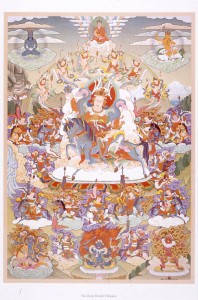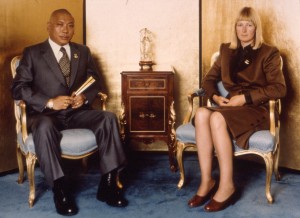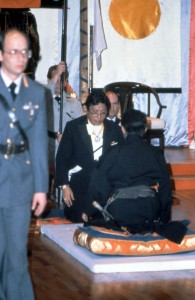Friday
Dharma TeachingsShambhala Lineage, by Chogyam Trungpa

The Dorje Dradul Thangka, showing the Vidyadhara in his ultimate form. Designed by HHDilgo Khentse Rinpoche and Sakyong Mipham Rinpoche.
Fundamentally, the notion of lineage in the Shambhala teachings is connected with how the wisdom of the cosmic mirror is transmitted and continued in human life, human existence. The quality of the cosmic mirror is that it is unconditioned, vast open space. It is an eternal and completely open space, space beyond question. In the realm of the cosmic mirror, your mind extends its vision completely, beyond doubt. Before thoughts, before the thinking process takes place, there is the accommodation of the cosmic mirror, which has no boundary—no center and no fringe. As we discussed, the way to experience this space is through the sitting practice of meditation.
Experiencing the realm of the cosmic mirror gives rise to wisdom—the wisdom of vast and deep perception, beyond conflict, which is called drala. There are various levels of experiencing drala. The primordial or ultimate level of drala is experiencing directly the wisdom of the cosmic mirror. When you experience that wisdom, then you are contacting the origin of the Shambhala lineage, the source of wisdom.
So, when you contact the wisdom of the cosmic mirror, you are meeting the ultimate dralas, the Rigden kings of Shambhala. Once having made a connection to ultimate drala, it is possible for the primordial wisdom and vision of the Rigden kings to be passed down to the level of human perception. The vastness of perception can be captured in simplicity, a single perception, on the spot. When we allow vastness to enter our perception, then it becomes drala; it becomes brilliant and luminous—magical. When we have this experience, then we are meeting what are called the inner dralas. The inner dralas are empowered by the wisdom of the cosmic mirror, the Rigdens, to manifest brilliance and elegance in this phenomenal world.
Finally, the wisdom of ultimate and inner drala can be transmitted to a living human being. In other words, by realizing completely the cosmic mirror principle of unconditionality and by invoking that principle utterly in the brilliant perception of reality,a human being can become living drala—living magic. That is how one joins the lineage of Shambhala warriors and becomes a master warrior—not just by invoking but by embodying drala.
The master warrior embodies the outer drala principle. The basic quality of the master warrior is that his presence evokes the experience of the cosmic mirror and the magic of perception in others. That is, his very being transcends duality on the spot, and thus he is said to have complete authentic presence. When the warrior students experience this overwhelming genuineness, it allows them and provokes them to go beyond their own selfishness, beyond ego, in an instant. The master warrior has relaxed completely into the unconditional purity of the cosmic mirror. Therefore, he has experienced unconditional wakefulness, free from ego. Because he always has access to that unconditioned space, he is never subject to the confusion or sleepiness of selfishness, at all. He is totally awake. And thus, also, the energy of the master warrior is always connected with ultimate drala, the vast vision of the Rigden kings. So he is free from confusion.
Because the master warrior has completely identified himself with the lineage of wisdom of the Rigden kings, he begins to develop great tenderness, great compassion, which is witnessing basic goodness in all beings. When the master warrior views the world around him, he knows that all human beings possess basic goodness and that they are entitled to realize the principle of their own genuineness, at least. And beyond that, they have the possibility to give birth to the universal monarch in themselves.

Chogyam Trungpa and Lady Diana seated at the Kalapa Court, Boulder in the early 1980s. Photo by Blair Hansen
Finally, the master warrior, out of his great compassion for human beings, is able to join heaven and earth. That is to say, the ideals of human beings and the ground where human beings stand can be joined together by the power of the master warrior. Then heaven and earth begin to dance with each other, and human beings feel that there is no quarrel about who possesses the best part of heaven or the worst part of earth.
In order to join heaven and earth, you need confidence and trust in yourself. Beyond that, in joining heaven and earth, you have to go beyond selfishness. If someone thinks: “Now I have it? Ha, ha!”—that doesn’t work. Joining heaven and earth happens only if you go beyond an egoistic attitude. No one can join heaven and earth together if he is selfish, because then he has neither heaven nor earth. He is stuck instead in a plastic realm, an artificial realm, which is horrific. Joining heaven and earth comes only from passionlessness, transcending desire. If the master warrior were drunk on his own authentic presence, then it would be disastrous.
The master warrior is very humble, extremely humble. His humbleness comes from working with others. When you work with others, you realize the need to be patient, to give space and time to others to develop their own understanding of goodness and of warriorship. If you are frantic and try to push basic goodness onto others, then nothing happens except further chaos. Knowing that, you become extremely humble and patient in working with others.
The master warrior guides his students with patience, and he also provides gentleness—being without
aggression. Then, he also guides his students by being true—being stable and solid. If truth were like a
fluttering flag in the wind, you would never know which side you were looking at. So the idea here is that being true is being solid and completely stable, like a mountain. You can rely on the sanity of the master warrior; it never wavers. He is completely genuine.
Because there is no fear in the master warrior’s own state of mind or in his physical being, the process of helping others takes place constantly. The mind of the master warrior is thoroughly free from laziness. In extending himself fearlessly to others, the master warrior expresses intense interest in the activities of his students — from the level of what they have for dinner up to the level of their state of mind, whether they are happy or sad, joyful or depressed. So mutual humor and appreciation can take place naturally between the master warrior and the warrior students.

Transmission of the Shambhala Lineage from the Druk Sakyong to Sakyong Mipham Rinpoche. Boulder, 1979. Photo by Hudson Shotwell.
Altogether then, the idea of lineage in the Shambhala teachings relates to one’s connection with primordial wisdom. That wisdom is accessible and extremely simple, but also vast and profound. The way to despotism and corruption lies in clinging to concepts, without access to a pure realm in which hope and fear are unknown. In the realm of the cosmic mirror, clinging to concept and doubt has never been heard of, and those who have proclaimed the true goodness, the innate primordial goodness, of human beings, have always had access to this realm, in some form.
Over the centuries, there have been many who have sought the ultimate good and have tried to share it with their fellow human beings. To realize it requires immaculate discipline and unflinching conviction. Those who have been fearless in their search and fearless in their proclamation belong to the lineage of master warriors, whatever their religion, philosophy, or creed. We should venerate their example and acknowledge the path that they have laid for us. They are the fathers and mothers of Shambhala, who make it possible, in the midst of this degraded age, to contemplate enlightened society.
From Shambhala: The Sacred Path of the Warrior, by Chögyam Trungpa; © 1984 by Chögyam Trungpa. Condensed from pages 202 to 211 in the Shambhala Library Edition. Reprinted by arrangement with Shambhala Publications, Inc., Boston, MA. www.shambhala.com. Click here to order this title
















